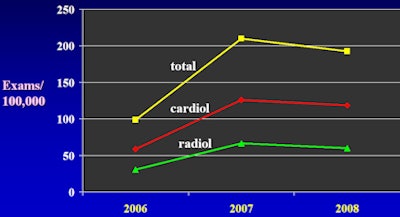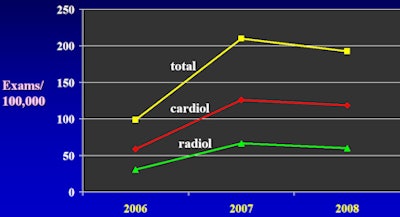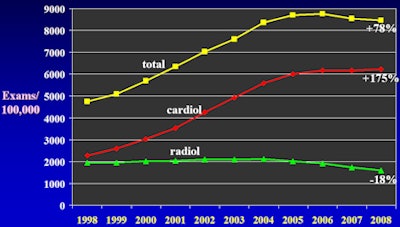
The use of coronary CT angiography (CCTA) has fallen faster than that of radionuclide myocardial perfusion imaging (MPI), and CCTA may be underused due to lack of referrals from cardiologists who control MPI equipment, according to a new study presented at the RSNA meeting earlier this month.
Coronary CT angiography provides valuable information not found on MPI scans, and the fact that CCTA utilization rates are far lower than MPI rates -- and have been falling at a faster rate in the past couple of years -- may be a sign of underutilization in the U.S., according to David Levin, MD, and colleagues from Thomas Jefferson University in Philadelphia.
"An MPI test can be negative but the patient can still have significant coronary artery disease," Levin told AuntMinnie.com. "Even a 60% narrowing of a major coronary artery wouldn't show up on MPI -- it's not enough to reduce blood flow -- and if it doesn't reduce blood flow, the exam doesn't show the perfusion effect. On the other hand, if a CTA is negative, you can assure the patient that they don't have coronary artery disease."
Levin and colleagues compared CCTA utilization trends with MPI using Medicare Physician/Supplier Procedure Summary Master Files from 1998 to 2008. The team identified CPT codes for MPI and CCTA and calculated utilization rates for both techniques per 100,000 Medicare beneficiaries, in addition to calculating year-over-year percent changes. The researchers tracked MPI growth rates from 1998 to 2008 and CCTA rates from 2006 to 2008. The group also used Medicare physician specialty codes to identify studies performed by radiologists and cardiologists.
"CCTA is a relatively new technique that has attracted widespread attention among both cardiologists and radiologists," Levin told RSNA attendees. "CCTA and MPI are considered to be competing techniques for imaging patients with suspected coronary artery disease."
Levin's team found that in 2006 a total of 99 CCTA exams per 100,000 Medicare beneficiaries were performed, rising to 210 per 100,000 in 2007 (+112%) but then dropping to 194 in 2008 (-8%). In comparison, in 2006 a total of 8,753 MPI exams per 100,000 beneficiaries were performed, dropping to 8,548 in 2007 (-2%) and then dropping again to 8,467 in 2008 (-1%).
CCTA rates per 100,000 beneficiaries among radiologists were 31 in 2006, 67 in 2007 (+116%), and 60 in 2008 (-10%). Rates of procedure use among cardiologists were 59 in 2006, 126 in 2007 (+114%), and 119 in 2008 (-6%).
"Cardiologists are doing more CCTA exams than radiologists," Levin said.
MPI rates per 100,000 beneficiaries among radiologists were 1,906 in 2006, 1,736 in 2007 (-9%), and 1,601 in 2008 (-8%), while among cardiologists, the MPI rates were 6,168 in 2006, 6,174 in 2007 (+0%), and 6,228 in 2008 (+1%).
"We found that there was also a slight reduction in overall MPI utilization in both 2007 and 2008," Levin said. "This reduction was much more pronounced among radiologists, whereas among cardiologists the rate remained essentially flat."
 |
| CCTA utilization rate per 100,000 Medicare beneficiaries: 2006-2008. All images courtesy of David Levin, MD. |
 |
| MPI utilization rate per 100,000 Medicare beneficiaries: 1998-2008. |
Why did radiologists' use of CCTA decrease in 2008, despite its proven value? This could be due to multiple factors, Levin said, including unfavorable reimbursement, the time-consuming nature of the procedure, lack of necessary equipment and trained personnel, concerns about radiation exposure, preauthorization requirements, and more rigorous application of appropriateness criteria.
"CCTA exams are not like most CT scans, where a tech does the whole study and it can be read quickly by someone with experience," Levin told AuntMinnie.com. "It can take a lot of time, using specialized software [to interpret the images], and if the image quality is affected, more time may be needed in postprocessing."
But turf battles between cardiologists and radiologists are another cause, according to Levin.
"[The drop in CCTA use can also be attributed to] cardiologist ownership of SPECT cameras, and their unwillingness to give up potential revenue by referring patients for CCTA," he said.
During the study time frame, MPI use also dropped because of less use by radiologists, Levin said, although MPI is still performed approximately 44 times more often than CCTA.
"Given that CCTA provides different -- and, in many ways, better -- information than MPI in patients with suspected coronary disease, the technology is being underutilized in the Medicare population," Levin said. "What should the actual ratio between the two tests be? Maybe 2-to-1, or even 1-to-1, but certainly not anywhere near 44 MPI exams for every CCTA."
By Kate Madden Yee
AuntMinnie.com staff writer
December 28, 2010
Related Reading
CAD boosts new readers in diagnosing stenosis on CCTA, November 28, 2010
CONFIRM registry fills in CCTA evidence gaps, November 15, 2010
Supersized CONFIRM trial tackles coronary CTA and mortality, July 30, 2010
Cardiac model favors treadmill then CTA for low-risk patients, June 7, 2010
Cardiac CAD safely rules out coronary artery disease, June 1, 2010
Copyright © 2010 AuntMinnie.com





















